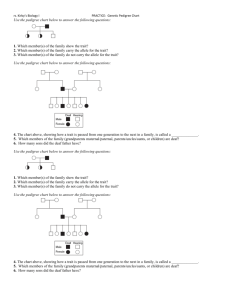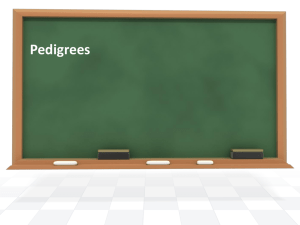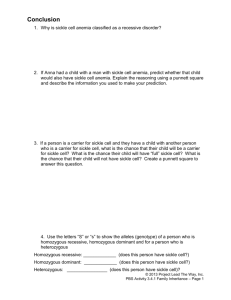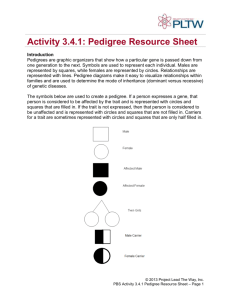Activity 3.4.1: Family Inheritance Introduction In the previous lesson
advertisement
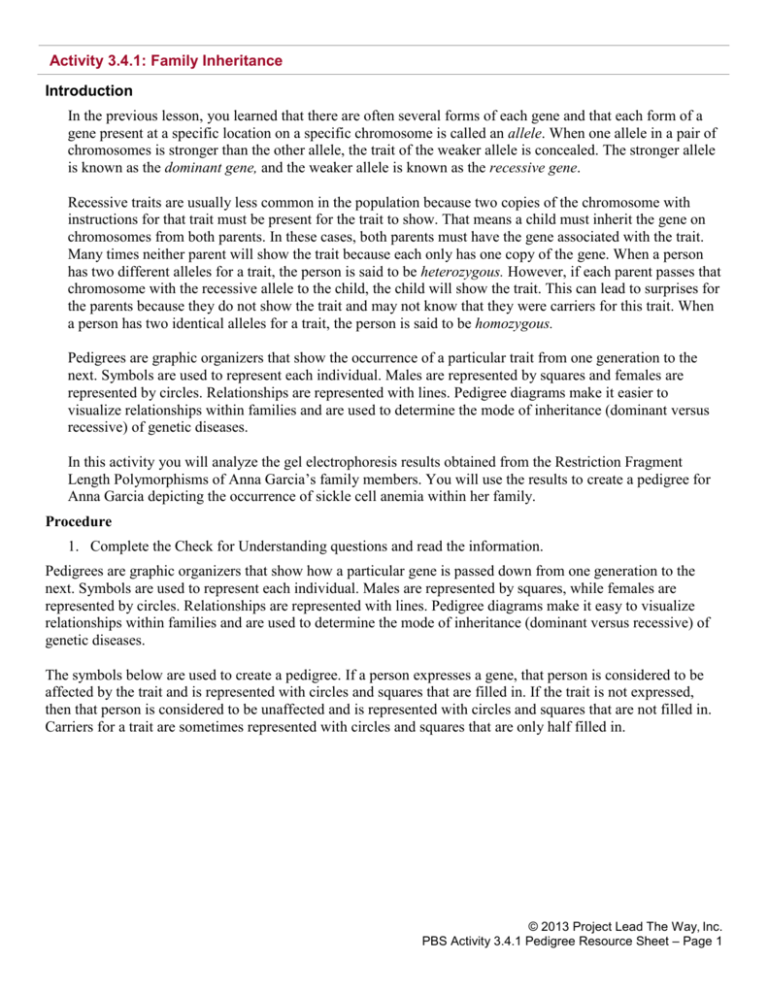
Activity 3.4.1: Family Inheritance Introduction In the previous lesson, you learned that there are often several forms of each gene and that each form of a gene present at a specific location on a specific chromosome is called an allele. When one allele in a pair of chromosomes is stronger than the other allele, the trait of the weaker allele is concealed. The stronger allele is known as the dominant gene, and the weaker allele is known as the recessive gene. Recessive traits are usually less common in the population because two copies of the chromosome with instructions for that trait must be present for the trait to show. That means a child must inherit the gene on chromosomes from both parents. In these cases, both parents must have the gene associated with the trait. Many times neither parent will show the trait because each only has one copy of the gene. When a person has two different alleles for a trait, the person is said to be heterozygous. However, if each parent passes that chromosome with the recessive allele to the child, the child will show the trait. This can lead to surprises for the parents because they do not show the trait and may not know that they were carriers for this trait. When a person has two identical alleles for a trait, the person is said to be homozygous. Pedigrees are graphic organizers that show the occurrence of a particular trait from one generation to the next. Symbols are used to represent each individual. Males are represented by squares and females are represented by circles. Relationships are represented with lines. Pedigree diagrams make it easier to visualize relationships within families and are used to determine the mode of inheritance (dominant versus recessive) of genetic diseases. In this activity you will analyze the gel electrophoresis results obtained from the Restriction Fragment Length Polymorphisms of Anna Garcia’s family members. You will use the results to create a pedigree for Anna Garcia depicting the occurrence of sickle cell anemia within her family. Procedure 1. Complete the Check for Understanding questions and read the information. Pedigrees are graphic organizers that show how a particular gene is passed down from one generation to the next. Symbols are used to represent each individual. Males are represented by squares, while females are represented by circles. Relationships are represented with lines. Pedigree diagrams make it easy to visualize relationships within families and are used to determine the mode of inheritance (dominant versus recessive) of genetic diseases. The symbols below are used to create a pedigree. If a person expresses a gene, that person is considered to be affected by the trait and is represented with circles and squares that are filled in. If the trait is not expressed, then that person is considered to be unaffected and is represented with circles and squares that are not filled in. Carriers for a trait are sometimes represented with circles and squares that are only half filled in. © 2013 Project Lead The Way, Inc. PBS Activity 3.4.1 Pedigree Resource Sheet – Page 1 Each row of the pedigree diagram indicates one generation, and the connecting lines indicate a direct relationship between individuals. The generations are listed using Roman numerals. The individuals within each generation are indicated by Arabic numerals. The order of birth within a generation is indicated by placing the first born at the far left and progressing from left to right with each subsequent child. The pedigree below indicates a man and a woman in generation I who had three sons and who are the grandparents of twin girls. The oldest son showed the trait, but his two younger brothers did not. The youngest son had twin daughters. The oldest son is referred to as individual II-1, for generation two, first born. His mother would be referred to as I-2, for generation one, second individual. His nieces would be III1 and III-2, for generation three, first and second individuals, respectively. Check for Understanding: 1. Did either of the twin daughters, III-1 or III-2, show the trait? © 2013 Project Lead The Way, Inc. PBS Activity 3.4.1 Pedigree Resource Sheet – Page 2 Check for Understanding: 2. Would it be possible for individual II-4 to have two unaffected parents? 3. If individual III-1 mates with an unaffected individual, what is the percent chance of transmitting the trait to their child? Recessive traits are passed on to children from both parents, although the parents may seem perfectly "normal." Characteristics of recessive pedigrees are: 1) An individual who is affected may have parents who are not affected 2) All children of two affected individuals are affected Check for Understanding: 4. Individuals I-1 and I-2 are said to be _____________. 5. If individual II-1 mates with an affected individual, what is the percent chance that their offspring will be affected? Probability in Pedigrees © 2013 Project Lead The Way, Inc. PBS Activity 3.4.1 Family Inheritance – Page 3 Punnett squares can be used in conjunction with pedigrees in order to calculate the probability that an individual has or will receive the mutated chromosome that causes the abnormal hemoglobin associated with the sickle cell trait and disease. 2. Analyze the pedigree to determine the genotypes of the parents. Use the Pedigree Resource Sheet as your guide. 3. Calculate the probability that the child will have sickle cell disease or be a carrier. Complete a Punnett square and show your calculations in your lab notebook. Pedigree 1: Probability the child will have sickle cell disease is ______________________. Probability the child will be a carrier for sickle cell disease is __________________. Pedigree 2: Calculations: © 2013 Project Lead The Way, Inc. PBS Activity 3.4.1 Family Inheritance – Page 4 Probability the child will have sickle cell disease is ____________________. Probability the child will be a carrier for sickle cell disease is __________________. Calculations: Probability the child will have sickle cell disease is ____________________. Probability the child will be a carrier for sickle cell disease is __________________. 4. Note that one of the biomedical science professionals responsible for investigating, diagnosing, and counseling individuals who may have a genetic condition and their familiesare called clinical geneticists. 5. Analyze the gel electrophoresis results below for Anna’s family members. Because of differences in the genetic code, DNA cut with the same restriction enzyme will produce different cuts. This results in different size DNA pieces, which creates different banding patterns on gel electrophoresis. Therefore Restriction Fragment Length Polymorphisms can be used to diagnose genetic disease status. Remember that sickle cell anemia is an inherited recessive disorder. Determine which of Anna’s family members have sickle cell anemia, which members are carriers, and which family members are unaffected. Record your analysis in your laboratory journal. © 2013 Project Lead The Way, Inc. PBS Activity 3.4.1 Family Inheritance – Page 5 Note: Carlos – Anna’s Father Eric – Anna’s Brother Juanita – Anna’s Sister Jason – Juanita’s Husband/Anna’s Brother-In-Law Erin – Juanita and Jason’s Daughter 6. Use the Pedigree Resource Sheet to help you create a pedigree for Anna Garcia depicting the occurrence of sickle cell anemia within her family. Draw the pedigree on the Genetic Analysis section of the Activity 3.1.2 Medical History Resource Sheet. Make sure to correctly label each generation. If desired, also include a copy of your gel picture. 7. Answer the Conclusion questions. Conclusion 1. Why is sickle cell anemia classified as a recessive disorder? 2. If Anna had a child with a man with sickle cell anemia, predict whether that child would also have sickle cell anemia. Explain the reasoning and describe the information you used to make your prediction. 3. How does your predicted percent chance that an offspring would have sickle cell anemia or be a carrier compare to your experimental results? 4. Explain how a genetics counselor or a doctor could use these calculations of probability to counsel prospective parents. 5. Anna’s mother passed away three years ago, so she was unavailable for genetic testing. Based upon Anna’s family pedigree that you created in the previous activity, determine her mother’s possible © 2013 Project Lead The Way, Inc. PBS Activity 3.4.1 Family Inheritance – Page 6 genotypes and phenotypes related to sickle cell anemia. Explain your reasoning and describe the information you used to make your prediction. 6. Juan’s family has a history of sickle cell disease. His father died of sickle cell disease complications when Juan was six years old. He remembers his father being in great pain. Juan marries Gina. Gina’s maternal grandmother and paternal grandfather had sickle cell disease, but neither of her parents has the disease. Juan does not want to have children because he is convinced they will have sickle cell disease. Gina is not so sure. They have come to you for advice about having whether or not to have children. Based on your calculations of the probability of their child getting sickle cell disease, what is your advice? Show your calculations and explain your reasoning for your response. It may be helpful for you to draw pedigrees and possible Punnett squares for both Juan’s and Gina’s families. © 2013 Project Lead The Way, Inc. PBS Activity 3.4.1 Family Inheritance – Page 7
